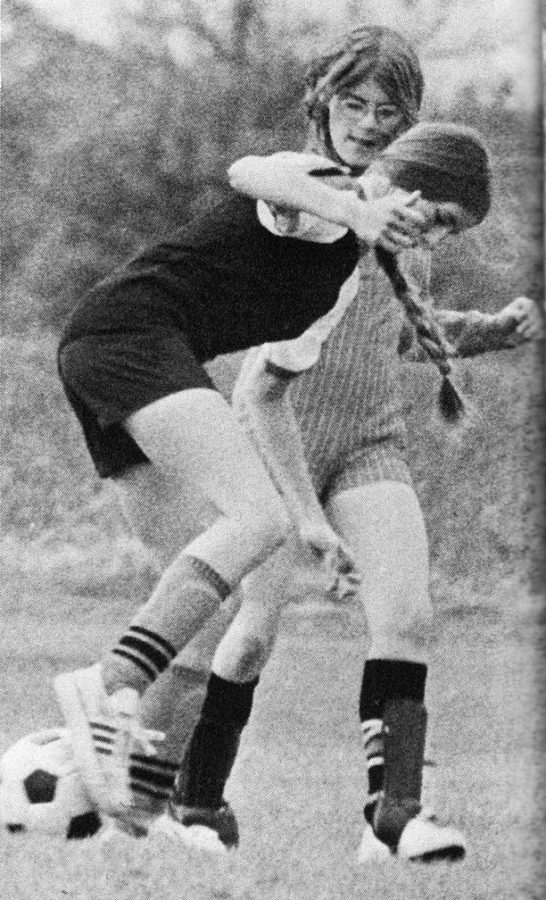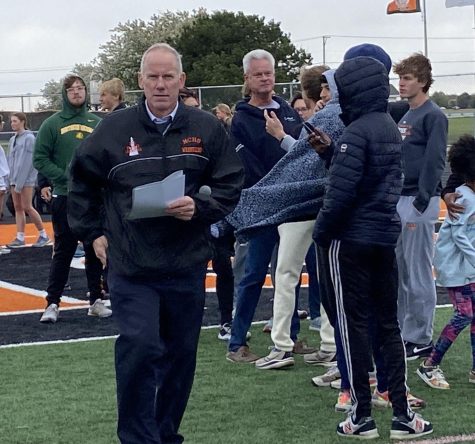Fighting To Be First: Girls Team Sports Arrive
Soccer, volleyball and track & field begin during the 1973-74 school year
Minooka’s first girls soccer team started in the fall of 1973.
This is the second of a three-part series on the history of girls athletics at MCHS. Read part one here.
“The question wasn’t if, but when we would start a program, we saw Title IX coming,” said Ron Lehman, the principal when Title IX took effect and MCHS began a new girls sports program. At Minooka, Lehman had also served as a teacher, coach, and athletic director for years.
He said Minooka was prepared for girls sports to take place and even wanted them to thrive.
“Our school took the attitude that if you were going to do it, do it. We didn’t need to buy the very best equipment, but we could get what we needed,” said Lehman.
The first girls sports to come to Minooka during the 1973-74 school year were soccer, volleyball, and track and field. The girls wanted to try their hand at playing sports for the school, especially the girls who were in the Girls Athletic Club, a group that had been formed a decade earlier and — outside of cheerleading — was the only opportunity for girls in school athletics
“The whole school took the attitude of ‘we’re going to be able to do the best we can.’ It was a learning experience,” said Lehman.
The First Teams
On the first girls soccer team in the fall of 1973, there were a total of 24 girls. Mindy McCarter and Mary Hunkler were the team captains. Ms. Patsy Martin was the head coach. In fact, she coached pretty much everything.
The girls only had four games that year — three home and one away, all in October, according to the Peace Pipe Chatter. They practiced every night for two weeks and the PPC said that they were looking pretty good. They practiced on a field north of the school building, where bleachers were planned.
Minooka lost the first game of the season on Oct. 4 to Marseilles, 11-0.
Helping out with the team was Gerd G. Krisch, also known as “Georg.” He was born overseas and learned in Germany how to play soccer.
His wife, Mari Kirsch, said “He played men’s soccer, European style. That’s what he would have taught. Side kick, goalie kick… He taught it very physically, because that’s how he played. When he coached at the Park District, it was little kids, so he didn’t teach it as physically.”
He unfortunately passed away on May 2, 2010.
“I had a daughter on the first soccer teams,” Lehman said. “We would go to games and cheer when the ball went past midfield. A goal was a big deal then. … We weren’t that big of a school, so we only had a handful of girls, but some were great athletes.”
Later that school year, girls could also participate in volleyball and track and field.
The volleyball team was divided into two, a freshman/sophomore team and a varsity team coached by Martin. She put a lot of work into coaching the girls, and her hard work really paid off.
The PPC reported that the girls were excited to play. Despite the fact that it was many of the girls’ first time competing, they did really well. Each team played a total of 5 games. Varsity won every game but one, and the fresh/soph team finished with a record of 3-2.
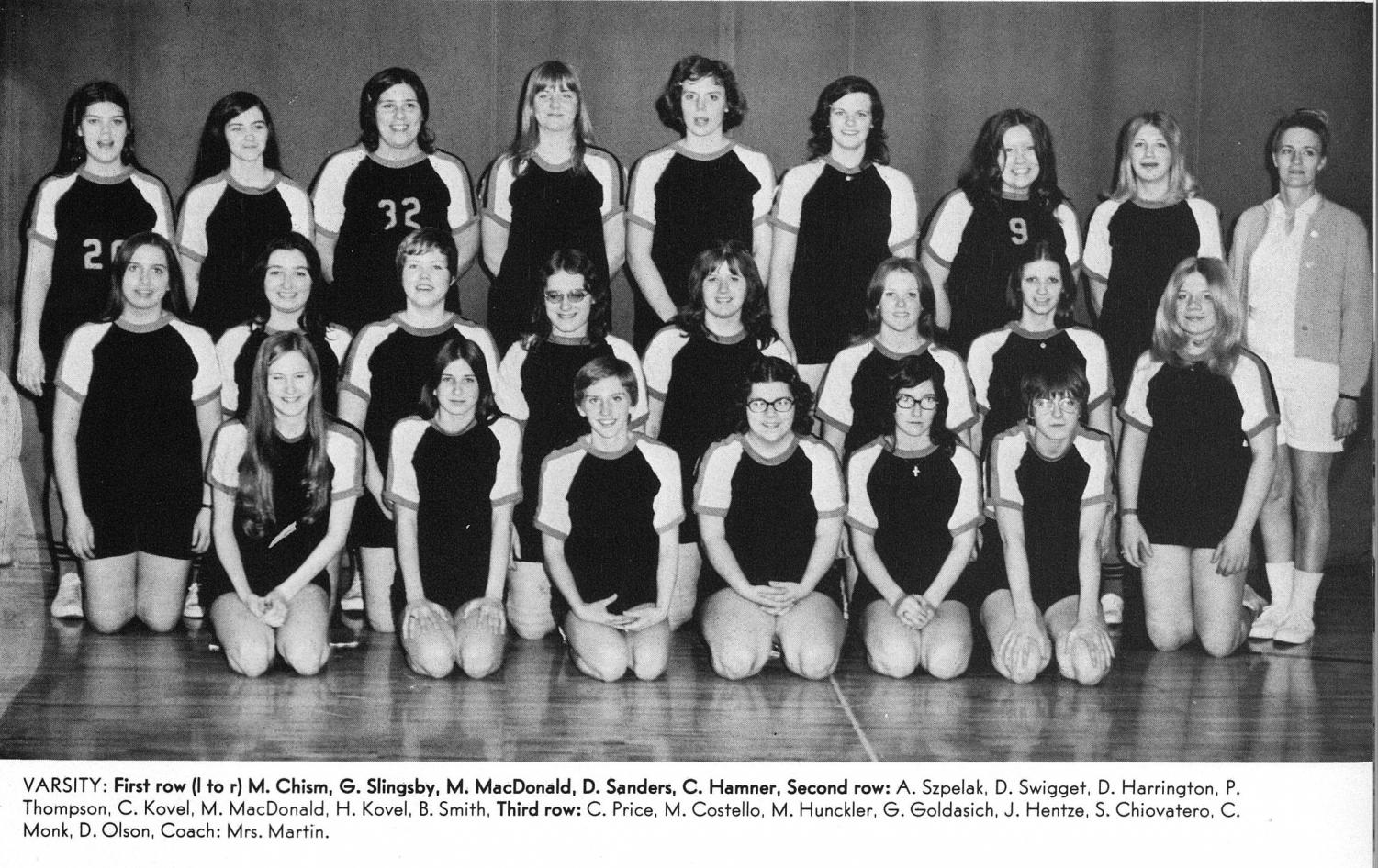
Once the volleyball season finished up, many of the same girls went with Martin to give track a try. There were 32 girls on the team that year. They were given their own sweats and sweatshirts with their team name on them to wear over their competition uniforms.
All the time spent outside practicing was worth it. Top marks at the district meet, similar to today’s regionals, were earned by Cheryl Miller, taking 1st in the 80-yard low hurdles and 2nd in the 110-yard low hurdles. Gail Goldasich was 4th in the discus, and Kathy Kopelman was 5th in the 80-yard low hurdles.
Basketball Beginnings
Girls basketball wouldn’t start for four more years.
“They didn’t want girls basketball here even though the conference was doing it,” Lyn Andracke said. “They would have been in the way. Girls weren’t interested in playing basketball (they thought).”
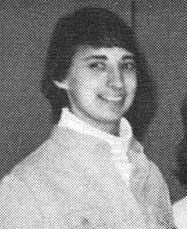
Andracke was hired by Lehman in 1976 to teach physical education and social studies. She said she figured one of the main reasons he hired her was because she had experience coaching girls sports.
Lehman said that was correct.
“It was tremendously hard to find female teachers with experience coaching,” he said.
Andracke coached multiple sports throughout her career, including being the first girls basketball coach.
Previous forms of girls basketball around the country had included six players from each team on the court where some players had to remain on one half of the court. Then the IHSA came in and said they would play five-on-five like the boys did.
Andracke wanted to prove there was interest in girls playing basketball at Minooka. She got more than 100 girls to sign up. Then she put together a round robin tournament for the girls. She recruited other female teachers like Pillsbury to volunteer to help run the tournament to prove there was interest.
“And that’s how we finally got a girls basketball team,” Andracke said.
The team photo from the first girls basketball team during the 1977-78 season shows 16 girls, Andracke, and assistant coach Sue Poole. They wore a simple ringer t-shirt with only the player’s number on the front. The team played just five games that year and finished with a record of 0-5.
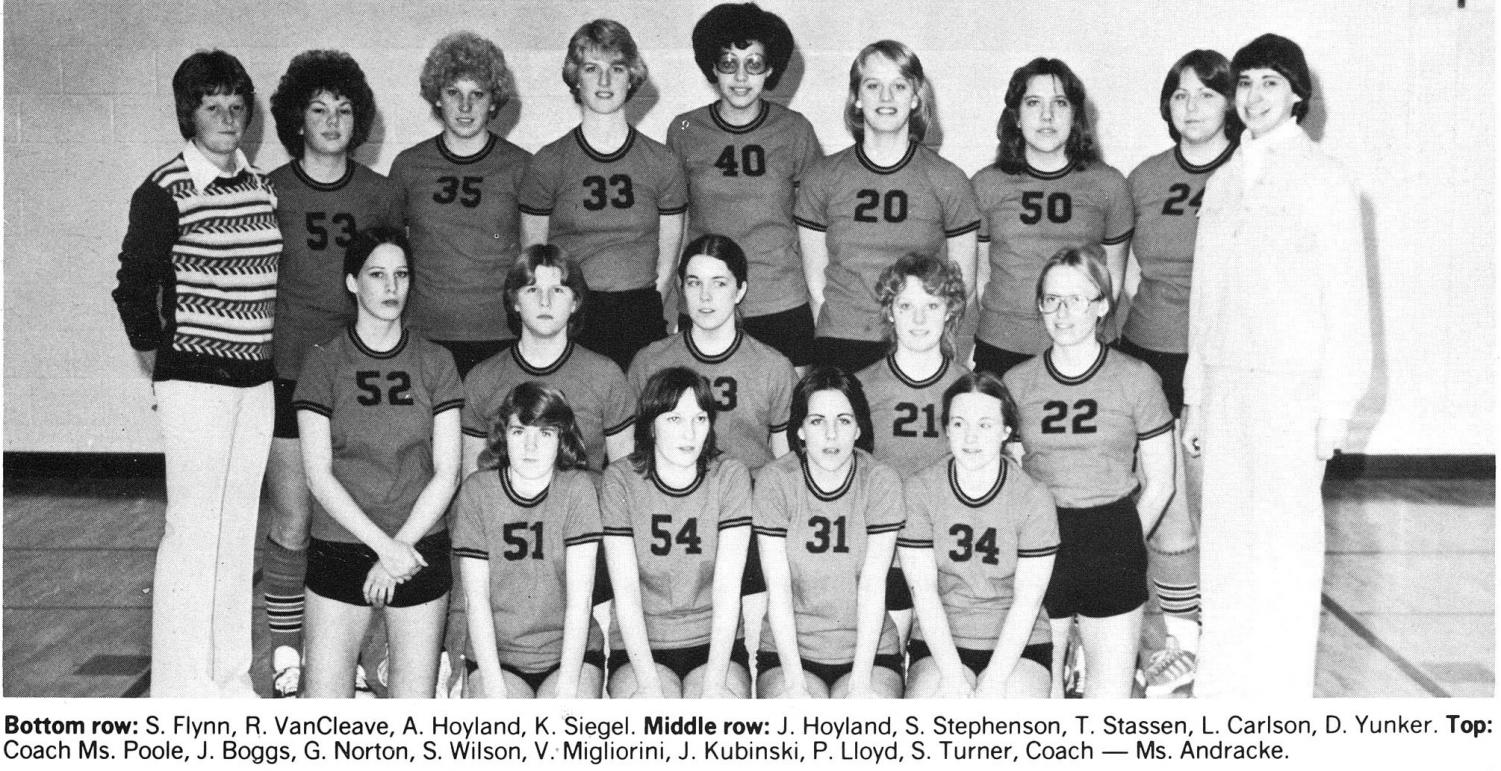
The IHSA had started the first girls state basketball tournament the previous season at Illinois State University. The Minooka girls would win their first IHSA regional title during the 1979-80 season with Poole as the head coach.
The Minooka girls program was not the only school in the area fighting to be established. Ms. Johnna Franklin, Minooka health teacher, was on Mazon High School’s first basketball team after Title IX was passed. She played her first varsity game for Mazon in 1978 at Minooka against the Indians. She said that there were very few people in the stands and that all the referees were men. She said at Mazon, she and her teammates would have to leave the school to practice if it conflicted with the boys. “We had to get in a cargo van and travel 10 miles to use a gym at an elementary school that had a slippery floor and small court,” Franklin said. “But again we were just so happy to finally have a team that we didn’t think to complain about the inequity of the situation.”
Many of the female teachers at Minooka chipped in to help the programs get started.
Glenda Smith began teaching at Minooka in 1976, the same as Andracke. In her early years at MCHS, she kept score at girls volleyball and basketball games and timed races for track. She was also one of the volunteers who helped run Andracke’s round robin tournament to prove there were girls interested in basketball.
“There was a small core of girls athletes at that time, and I think that they bonded much more than the female athletes do now,” said Smith. “This is partly because now girls can be involved in so many things, whereas back then, there was a very limited number of things girls could participate in.
Smith said the same girls played all of the sports.
“They just went from one sport to another to another to another. We had some very talented female athletes over the course of time I was involved, and I think that their passion was amazing,” she said.
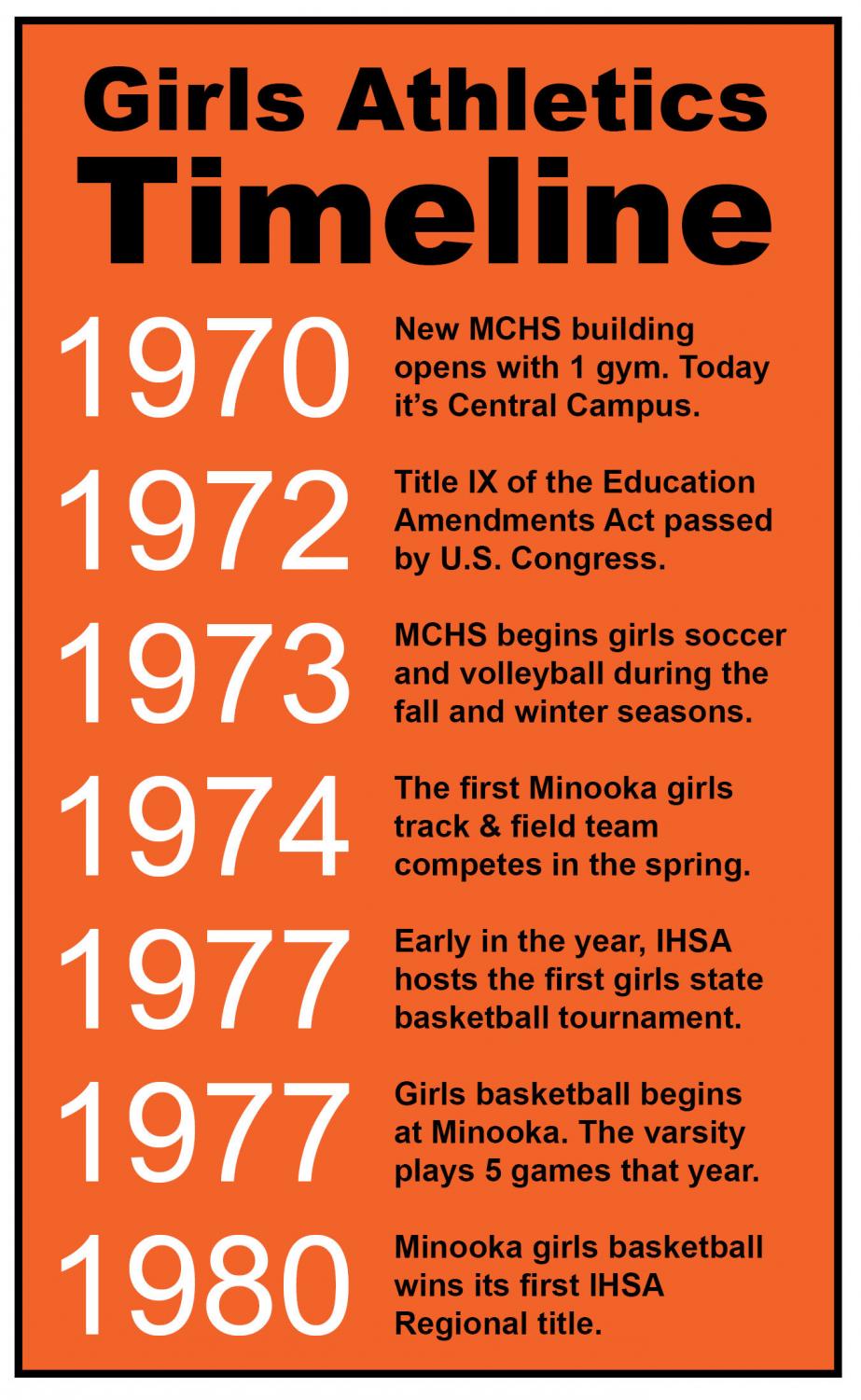
Sharing Space
After girls sports started in 1973, gym space became even more of an issue.
Wayne Greenbeck was the head men’s basketball coach at the time.
“When we moved in here (current Central Campus in 1970) we had just the one gym,” Greenbeck said.
Several former teachers and coaches remember the conflict.
“When the girls athletic program started, one of the first concerns we had (was) again at Central Campus, we only had one gym,” Ken Maas said. Maas was a math teacher and JV baseball coach at MCHS when girls sports started. Most recently he worked as a campus monitor at South Campus.
“So a lot of the concern is who’s going to use the gym space? … It wasn’t so much a negative thing, but it was tough to try and schedule all those different levels and different sports with using the same gym,” Maas said.
Cheryl Pillsbury, who taught English at MCHS for more than 40 years, had a similar memory.
“The only backlash, of which I was aware, was from coaches who did not want to share the facility. Every coach wanted the best for his/her team, and it took several years before there was equal opportunity afforded to all teams,” she said.
Does Lehman, the principal in 1973, remember gym space being an issue?
“Do I ever,” Lehman said. “We only had the one gym at the time. We divided up the time with some practice at 7:30 in the morning and other practicing at 6 or 7 at night. The biggest problem occurred during the winter sport season when things were indoors.”
There was an existing routine that had been in place for years: boys basketball would practice right after school at 3:30 p.m. and boys wrestling would practice once it was over, Andracke said. There was no rotation, which forced girls basketball to practice at 6 a.m.
Dissatisfied, Andracke proposed a new rotating schedule to Ray Adams, the athletic director. She had used such a schedule at Industry High School, where she had previously taught and coached. “And I, being the stupid person that I was and 20-something years old, said, ‘And if you don’t rotate this, I’m going to sue the school under Title IX,’” Andracke said.
Andracke said Adams responded by making a new schedule and calling in the boys basketball coaches at the time to work out the details. She said she happened to be outside the office when the meeting was over, and the boys coaches were so upset, they threw the schedule at her.
“They were furious they were going to have to practice at 6 a.m. I don’t think they talked to me for about three weeks,” she said.
Greenbeck said he didn’t remember the incident, and added that the first year the girls played a short schedule — five games — that was like a JV schedule because it was just starting. Historically when sports began at a school, they didn’t play a varsity schedule the first year. Minooka football had followed that pattern when it began in 1971.
Part three of the Fighting To Be First series was published on Monday, Nov. 23. You can read it HERE.



